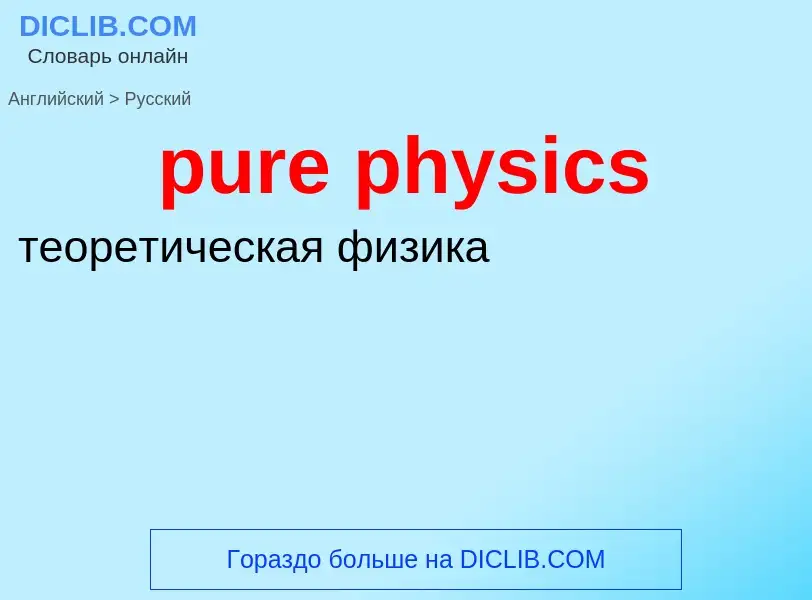Перевод и анализ слов искусственным интеллектом
На этой странице Вы можете получить подробный анализ слова или словосочетания, произведенный с помощью лучшей на сегодняшний день технологии искусственного интеллекта:
- как употребляется слово
- частота употребления
- используется оно чаще в устной или письменной речи
- варианты перевода слова
- примеры употребления (несколько фраз с переводом)
- этимология
pure physics - перевод на русский
['fiiziks]
общая лексика
физика
существительное
общая лексика
физика
учебник физики
устаревшее выражение
натурфилософия
Определение
Википедия
Plane of immanence (French: plan d'immanence) is a founding concept in the metaphysics or ontology of French philosopher Gilles Deleuze.
Immanence, meaning residing or becoming within, generally offers a relative opposition to transcendence, that which extends beyond or outside. Deleuze "refuses to see deviations, redundancies, destructions, cruelties or contingency as accidents that befall or lie outside life; life and death [are] aspects of desire or the plane of immanence." This plane is a pure immanence which is an unqualified immersion or embeddedness, an immanence which denies transcendence as a real distinction, Cartesian or otherwise. Pure immanence is thus often referred to as a pure plane, an infinite field or smooth space without substantial or constitutive division. In his final essay entitled Immanence: A Life, Deleuze wrote: "It is only when immanence is no longer immanence to anything other than itself that we can speak of a plane of immanence."


![[[Archimedes' screw]], a [[simple machine]] for lifting [[Archimedes' screw]], a [[simple machine]] for lifting](https://commons.wikimedia.org/wiki/Special:FilePath/Archimedes-screw one-screw-threads with-ball 3D-view animated small.gif?width=200)
![Velocity-distribution data of a gas of [[rubidium]] atoms, confirming the discovery of a new phase of matter, the [[Bose–Einstein condensate]] Velocity-distribution data of a gas of [[rubidium]] atoms, confirming the discovery of a new phase of matter, the [[Bose–Einstein condensate]]](https://commons.wikimedia.org/wiki/Special:FilePath/Bose Einstein condensate.png?width=200)
![The [[astronaut]] and [[Earth]] are both in [[free fall]]. (Pictured: Astronaut Bruce McCandless.) The [[astronaut]] and [[Earth]] are both in [[free fall]]. (Pictured: Astronaut Bruce McCandless.)](https://commons.wikimedia.org/wiki/Special:FilePath/Bruce McCandless II during EVA in 1984.jpg?width=200)
![A simulated event in the CMS detector of the [[Large Hadron Collider]], featuring a possible appearance of the [[Higgs boson]] A simulated event in the CMS detector of the [[Large Hadron Collider]], featuring a possible appearance of the [[Higgs boson]]](https://commons.wikimedia.org/wiki/Special:FilePath/CMS Higgs-event.jpg?width=200)
![[[Albert Einstein]] (1879–1955), whose work on the [[photoelectric effect]] and the theory of relativity led to a revolution in 20th century physics [[Albert Einstein]] (1879–1955), whose work on the [[photoelectric effect]] and the theory of relativity led to a revolution in 20th century physics](https://commons.wikimedia.org/wiki/Special:FilePath/Einstein1921 by F Schmutzer 2.jpg?width=200)
![universal gravitation]] were major milestones in classical physics universal gravitation]] were major milestones in classical physics](https://commons.wikimedia.org/wiki/Special:FilePath/GodfreyKneller-IsaacNewton-1689.jpg?width=200)

![The deepest visible-light image of the [[universe]], the [[Hubble Ultra-Deep Field]] The deepest visible-light image of the [[universe]], the [[Hubble Ultra-Deep Field]]](https://commons.wikimedia.org/wiki/Special:FilePath/Hubble ultra deep field high rez edit1.jpg?width=200)
![[[Galileo Galilei]] (1564–1642) showed a modern appreciation for the proper relationship between mathematics, theoretical physics, and experimental physics. [[Galileo Galilei]] (1564–1642) showed a modern appreciation for the proper relationship between mathematics, theoretical physics, and experimental physics.](https://commons.wikimedia.org/wiki/Special:FilePath/Justus Sustermans - Portrait of Galileo Galilei, 1636.jpg?width=200)
![[[Lightning]] is an [[electric current]]. [[Lightning]] is an [[electric current]].](https://commons.wikimedia.org/wiki/Special:FilePath/Lightning in Arlington.jpg?width=200)

![[[Max Planck]] (1858–1947), the originator of the theory of [[quantum mechanics]] [[Max Planck]] (1858–1947), the originator of the theory of [[quantum mechanics]]](https://commons.wikimedia.org/wiki/Special:FilePath/Max Planck (Nobel 1918).jpg?width=200)
![A typical phenomenon described by physics: a [[magnet]] levitating above a [[superconductor]] demonstrates the [[Meissner effect]]. A typical phenomenon described by physics: a [[magnet]] levitating above a [[superconductor]] demonstrates the [[Meissner effect]].](https://commons.wikimedia.org/wiki/Special:FilePath/Meissner effect p1390048.jpg?width=200)
![Experiment using a [[laser]] Experiment using a [[laser]]](https://commons.wikimedia.org/wiki/Special:FilePath/Military laser experiment.jpg?width=200)
![This [[parabola]]-shaped [[lava flow]] illustrates the application of mathematics in physics—in this case, Galileo's [[law of falling bodies]]. This [[parabola]]-shaped [[lava flow]] illustrates the application of mathematics in physics—in this case, Galileo's [[law of falling bodies]].](https://commons.wikimedia.org/wiki/Special:FilePath/Pahoeoe fountain original.jpg?width=200)

![Classical physics implemented in an [[acoustic engineering]] model of sound reflecting from an acoustic diffuser Classical physics implemented in an [[acoustic engineering]] model of sound reflecting from an acoustic diffuser](https://commons.wikimedia.org/wiki/Special:FilePath/Prediction of sound scattering from Schroeder Diffuser.jpg?width=200)
![[[Solvay Conference]] of 1927, with prominent physicists such as [[Albert Einstein]], [[Werner Heisenberg]], [[Max Planck]], [[Hendrik Lorentz]], [[Niels Bohr]], [[Marie Curie]], [[Erwin Schrödinger]] and [[Paul Dirac]] [[Solvay Conference]] of 1927, with prominent physicists such as [[Albert Einstein]], [[Werner Heisenberg]], [[Max Planck]], [[Hendrik Lorentz]], [[Niels Bohr]], [[Marie Curie]], [[Erwin Schrödinger]] and [[Paul Dirac]]](https://commons.wikimedia.org/wiki/Special:FilePath/Solvay conference 1927.jpg?width=200)
